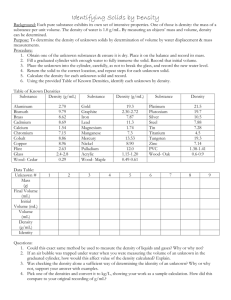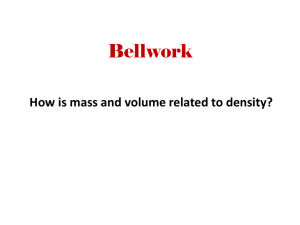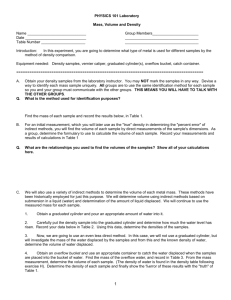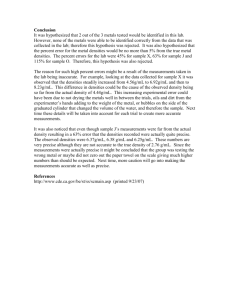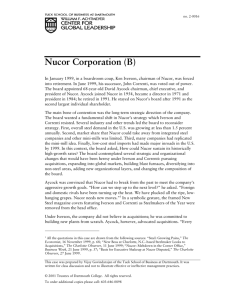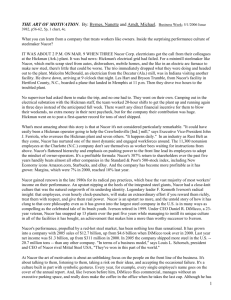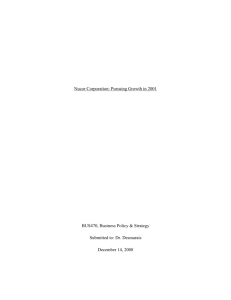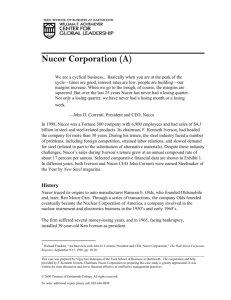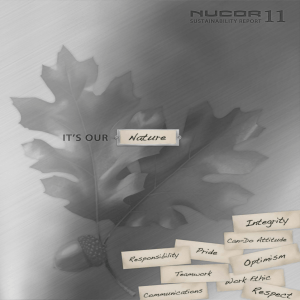Are You Dense? - Mechatronics
advertisement
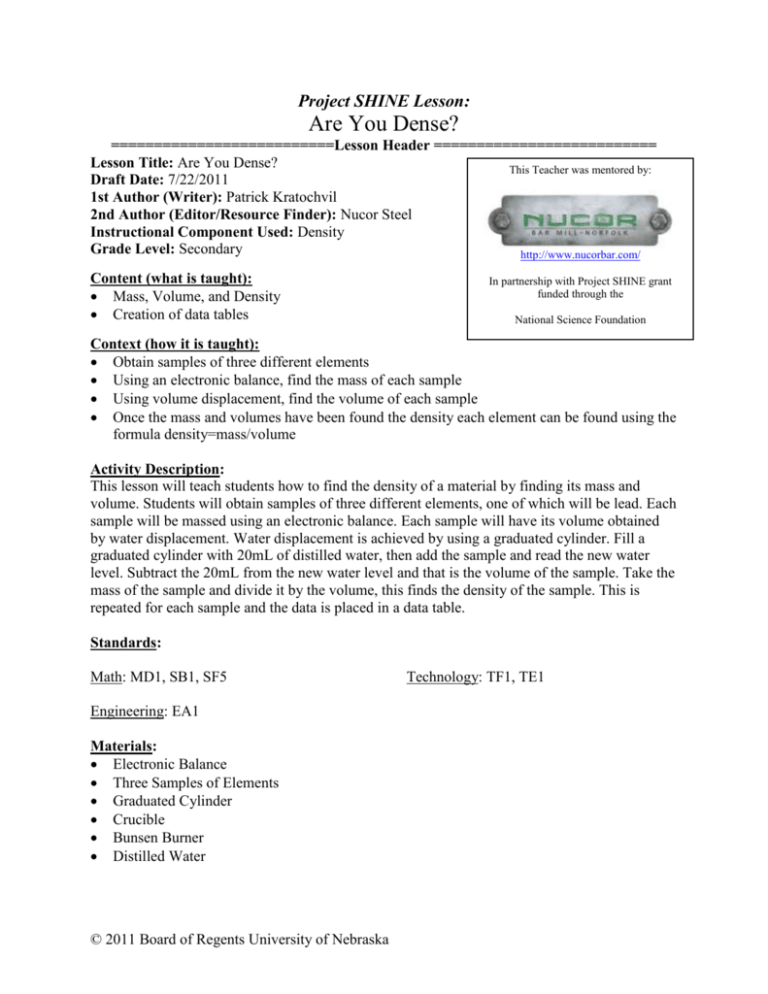
Project SHINE Lesson: Are You Dense? ==========================Lesson Header ========================== Lesson Title: Are You Dense? This Teacher was mentored by: Draft Date: 7/22/2011 1st Author (Writer): Patrick Kratochvil 2nd Author (Editor/Resource Finder): Nucor Steel Instructional Component Used: Density Grade Level: Secondary http://www.nucorbar.com/ Content (what is taught): Mass, Volume, and Density Creation of data tables In partnership with Project SHINE grant funded through the National Science Foundation Context (how it is taught): Obtain samples of three different elements Using an electronic balance, find the mass of each sample Using volume displacement, find the volume of each sample Once the mass and volumes have been found the density each element can be found using the formula density=mass/volume Activity Description: This lesson will teach students how to find the density of a material by finding its mass and volume. Students will obtain samples of three different elements, one of which will be lead. Each sample will be massed using an electronic balance. Each sample will have its volume obtained by water displacement. Water displacement is achieved by using a graduated cylinder. Fill a graduated cylinder with 20mL of distilled water, then add the sample and read the new water level. Subtract the 20mL from the new water level and that is the volume of the sample. Take the mass of the sample and divide it by the volume, this finds the density of the sample. This is repeated for each sample and the data is placed in a data table. Standards: Math: MD1, SB1, SF5 Engineering: EA1 Materials: Electronic Balance Three Samples of Elements Graduated Cylinder Crucible Bunsen Burner Distilled Water © 2011 Board of Regents University of Nebraska Technology: TF1, TE1 Asking Questions: (Are You Dense?) Summary: Students will be asked to consider how the density of a material helps to separate it from other materials and what how this is applied to the steel making industry. Outline: Students will consider the meaning of the word density and how it applies to separating different materials Students will learn how the densities of different materials are used to separate them from each other in the melting of recycled metal and forming new steel (i.e. Nucor Steel) Activity: Students will be introduced to the concept of density. I small groups, students will discuss the questions below. Questions How do you find the density of a material? How do you use differences in density of liquids to separate them? What is a good application of this property? What other applications of this property could one use it for? Answers density is mass divided by volume when material is melted to form a liquid, the lower density liquid will rise to the top this is a part of the process Nucor Steel uses this property is good for separating water from various materials Resources: Density Video: http://www.youtube.com/watch?v=Q4EBOE4pJyw (NOTE: Other videos can be found by typing in density at www.google.com) © 2011 Board of Regents University of Nebraska Exploring Concepts: (Are You Dense?) Summary: Students explore the density of various materials. Students will explore why this is important. Outline: Students will research why differences in densities is important Students will research density related to the steel making process Discussion of how the steel industry uses differences in density in their melting process Activity: Students will look up the densities of different elements (one of which should be lead). Next, students will research why these differences in densities are so important and how the density differences can be used. Finally, research will continue on how different densities are used in the steel making process in a plant like Nucor Steel. Zinc: 0.258 Pure Iron: 0.284 © 2011 Board of Regents University of Nebraska Lead: 0.41 Instructing Concepts: (Are You Dense?) Density Putting Density in Recognizable Terms: Density is defined as being equal to the mass of an object divided by the volume the object occupies. Putting Density in Conceptual Terms: Density is a relationship between the mass and volume of an object. If two objects have the same mass and occupy different volumes, the object with less volume has a higher density. Likewise if two objects have different masses and the same volume, the object with the bigger mass will have a higher density. Putting Density in Mathematical Terms: Mathematically density can be found using the mass formula: Density = . The standard (SI) unit for density is kg/m3. Although any Volume measure of mass to volume is technically acceptable. Density can be in mass per liquid volume as well. Sometimes it is difficult to measure the volume of an object in a traditional geometric way. For instance if the object is oddly shaped, you could measure the amount of fluid (water) it displaces and use that as the objects volume. Putting Density in Process Terms: Density of an object can be changed. Generally, if the temperature of an object increases, its density will decrease. (Water between 0 C and 4 C is an exception.) Similarly, if the object is put under higher pressure the density of the object will always increase. Putting Density in Applicable Terms: Density is applicable in many different real-world settings. These include: buoyancy, metal alloys, construction, aeronautics, fire extinguishers (CO2 is more dense than air) and engineering. NOTE: This list is far from exhaustive but is here to show the diversity of applications of density. Basically, density is important anytime someone wants to build something where weight and distribution of weight are critical. © 2011 Board of Regents University of Nebraska Organizing Learning: (Are You Dense?) Summary: Students will find the densities of three different solid substances using liquid displacement. NOTE: One of the substances needs to be lead. Once the density of the lead is obtained, the lead will be melted and formed into the liquid state. The density will again be calculated to ascertain if there is a difference in the density of liquid lead versus solid lead. Outline: Calculate the density of 3 solid substances using water displacement Melt lead and recalculate the density to see if there is a difference Write the results of the experiment. Activity: Students will work in groups of two to calculate the densities of three different substances. One of these substances needs to be lead. The students will obtain a sample of each substance and measure the mass using an electronic balance (a Triple-beam balance may also be used). The volume for each sample will be obtained by using volume displacement in a 100 mL graduated cylinder. Students will need to fill the graduated cylinder with 20 mL of water. Next the students will carefully place one of the samples in the graduated cylinder and write down the new volume reading of the water in the graduated cylinder. The sample volume is obtained by subtracting the 20 mL from the volume reading with the sample. Using the density formula, mass/volume = density, students will calculate the density for each sample and fill in the chart below. Students will then melt the lead sample over a Bunsen burner in a crucible with a lid on it. After the lead is melted, pour it into a graduated cylinder to obtain its liquid volume. Using this volume refigure the density of the lead. Compare the density of the liquid lead with the density of the solid lead. Is there a difference? Finally, students will report their results in a written or multimedia presentation. Sample Chart: Mass Substance A Substance B Solid Lead Liquid Lead © 2011 Board of Regents University of Nebraska Volume Density Understanding Learning: (Are You Dense?) Summary: Students will complete an assessment by calculating the densities of various substances. Students will need to demonstrate an understanding of the importance of knowing why differences in densities are important. Students will need to relate the difference in density to the steel making process and especially the scrap metal melting process that Nucor Steel uses. Outline: Formative assessment of density Summative assessment of density Activity: Students will complete written assessments and quiz assessments related to density. Formative Assessment: As students are engaged in the lesson ask these or similar questions: 1) Do students understanding why finding the density of an element or compound important? 2) Can students use the fact that two elements or compounds have different densities to make a conclusion? 3) Can students identify real world processes that use differences in densities as a way to separate elements or compounds? Summative Assessment: Students can complete the following writing prompt and quiz questions: 1) Explain the concept of density, what it measures, and why it is important. 2) If a piece of wood has a mass of 30kg and a volume of 30m3, what is its density? density = mass / volume 3) What is the density of a piece metal with a mass of 205g and a volume of 150cm3? (Hint: a conversion must be done to get it to kg/m3) 4) What is the mass of the water in a glass that has a volume of 0.5m3? Water has a density of 1kg/m3 © 2011 Board of Regents University of Nebraska

